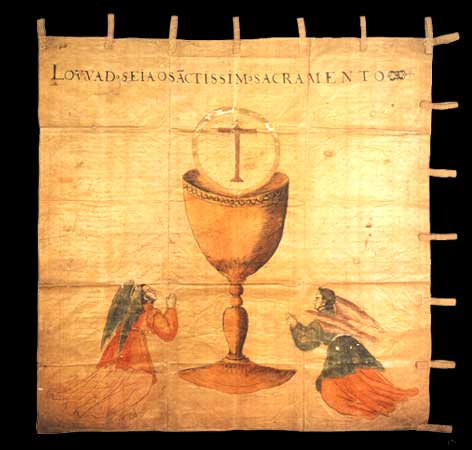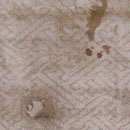
The content was adapted from text in Amakusa.tv homepage which was published in September 2001 [no longer exist], with my previous researched information. The images also taken from the website.

The Battle Flag (Jinjuki) is supposed
that it had been used by Amakusa Shiro's rebel army during Shimabara Uprising
(1637-1638). It is now keeping for memorial service celebration at Kirishitan-Kan
(Christian Hall) in Amakusa Municipal, Hondo City, Kumamoto Prefecture.
This flag was deposited with the hall in 1978, and started performing the memorial
service celebration from the following year on the Opening Memorial Day on August
1st every year.
On the day, approximately 20 members, such as Father Takuya Kawahara of Hondo
Caltholic Church, believers including hall management committees will attend
the memorial service and pray to console souls of the victims of Shimabara Uprising.
This battle flag is a square shaped,
with 108.6cm length and width. It is adapted as a flag by attaching seven eyelets
that allow a pole pass through at the top and the right of a figured satin China
silk.
The silk has a background pattern of chrysanthemum and swastika. At the top
of the flag, a Portuguese phrase, "LOVVAD
· SEIAOSÃCTISSIM · SACRAMENTO" which means
"Worship/Adore the Most Holy Sacrament " was written.
 For
the illustration, a calix, which the hostia with a cross places on its top,
was drawn at the center. The figures of angel joining their palms together worshiping
the holy calix were drawn on left and right sides.
For
the illustration, a calix, which the hostia with a cross places on its top,
was drawn at the center. The figures of angel joining their palms together worshiping
the holy calix were drawn on left and right sides.
The calix was colored in pale yellow, angels' wings were green and reddish-brown, and clothes were also pale yellow. Dark portion was colored in blackish brown and the lips were vermilion. On the whole, it becomes brown and it is surmised that it was probably washed once. (Click on the image to view enlarged image in another window)
 According
to rough drawing, it shows that the illustration was painted by an extremely
skillful artist; with the technique that is totally different from ink painting
in oriental drawings. It expresses the outline and the shade using an effective
mixture of roughness and fineness by lines like copperplate engraving images.
(Click on the image to view enlarged
image in another window)
According
to rough drawing, it shows that the illustration was painted by an extremely
skillful artist; with the technique that is totally different from ink painting
in oriental drawings. It expresses the outline and the shade using an effective
mixture of roughness and fineness by lines like copperplate engraving images.
(Click on the image to view enlarged
image in another window)
The painter was an accomplice of the rebel army in Hara Castle, Yamada Emosaku**, who was the only survivor from the battle. He probably drew the flag in Hara Castle or drew it before anti-Christian edicts as a sacredflag at a seminary. However, there is no corroboration.
 The
eyelets that allow a pole pass through were made from silk and cotton material
mixed together. This flag isalso conjectured that it has been made hurriedly.
The situation of severe battle can be observed from remained bloodstain and
the bow mark. (Click on the image
to view enlarged image in another window)
The
eyelets that allow a pole pass through were made from silk and cotton material
mixed together. This flag isalso conjectured that it has been made hurriedly.
The situation of severe battle can be observed from remained bloodstain and
the bow mark. (Click on the image
to view enlarged image in another window)
In addition, this flag was supposed that Nabeshima Daizen, the commander of
Nabeshima clan in Saga domain, led the troops to Hara Castle during the battle
and seized Amakusa Shirou's flag. After the end of uprising, the lord of the
clan received it for safekeeping; however, to praise Daizen's military exploit,
it was returned to Nabeshima clan, and has been told to posterity, Okayama clan,
from generation to generation till the 1950s.
After that, it had been possessed by many persons. Finally, it was designated
to be the important cultural property of the country in 1964. The possessor
in Dazaifu City, Fukuoka prefecture, presented it to Hondo City in 1995.
Although icons in Japanese Christian
period hardly exist in the origin of the thorough persecution; this battle flag
has been transmitted till today, recalls us unfortunate fate as a war spoil
from the ironical uprising.
It is also considered as one of the world's Three Great Battle Flags together
with the flag of Crusader and Joan of Arc. It has become the precious inheritance
of Amakusa as well as the world.
Although the replica is usually exhibited, during 2nd day of January to one week; 1st day of April, August, and November to 1 week respectively; and on Amakusa Martyrdom Festival (October 28th) and the order day, the original will be displayed in public.
*Father Christopher Zugger of Our Lady of Perpetual Help Byzantine Catholic Church in Albuquerque, New Mexico wrote me and told me the meaning of the phrase in Nov 2002. And Francisco Ruiz of Illinois Institute of Technology told me that the phrase is Portuguese, not Latin (in Latin it should be "Benedictum sit Sanctissimum Sacramentum") in Sep 2006. I really appreciate their assistance.
**According to some resources, Yamada Emosaku was believed that he was a traitor who survived from Shimabara uprising. He followed Matsudaira Nobusuna to Edo and worked for Bakufu government, such as examining for Kirishitan. One day, he suddenly returned to be Kirishitan and started propagating Christianity openly. Finally, he was arrested and imprisoned. No one knows about Emosaku's destiny.